Baroalba Hill 420 Circle
March 17-30, 2002
This article was written by Peter and Josephine Lawrence from Biloela in Queensland. The drawings are by Josephine, photos by Peter.
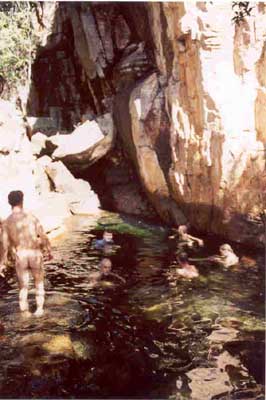 |
The March 2002 trip to Baroalba Creek & Hill 420 catered for the expectations of seven diverse bushwalkers. Rock art was the attraction for some, the motivation for others was camping on a high summit with 360° views, while cooling off in the numerous rock pools and relaxing in the quiet of the bush satisfied others. The opportunity to sketch the scenery motivated one; for the leader it was exploring new areas, and for another it was an Australian experience. The weather was kind to us bushwalkers - it rained once which left the rocks dry and safe for scrambling, and water plentiful for drinking and swimming.
|
| Baroalba Creek is an ideal place to gain an insight into the rock art of Arnhem Land including Kakadu. The rock galleries are numerous, the art is diverse, and camping spots in creek beds are comfortable. One evening however, after a rainstorm, the creek rose rapidly causing a quick shift to higher ground. Moonlight on the thundering waterfall gave an eerie impression of a wide curved wall. |
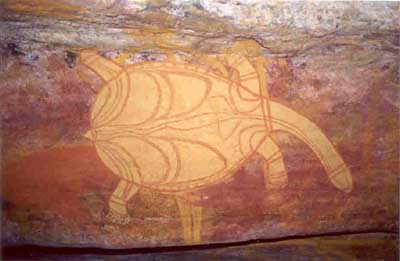 |
|
|
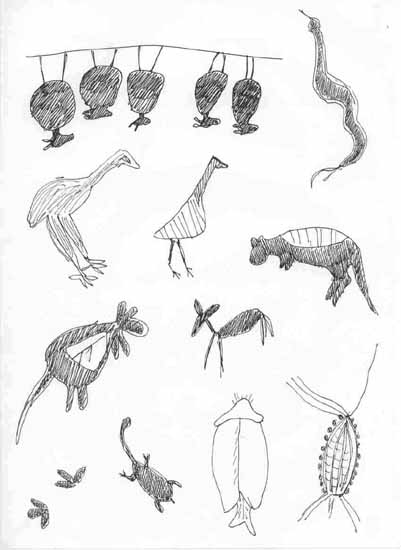 |
The rock art contains a range of styles and colours dating from the ancient pre-estuarine period to the recent freshwater period. Hunting and fighting activities are vividly portrayed in dynamic style drawings. The post-dynamic simple stick figures appear stiff but have character. Whereas yam figures, knobbly and hairy , are barely human. Solid figures, kangaroos, turtles, flying foxes, add splashes of colour to the art galleries. X-ray drawings of fish help identify these species. Engravings and bees-wax enhanced figures were occasionally found. Seeing paintings of the now extinct Thylacine was a delightful surprise. |
| The concentration of art at a particular shelter gives an indication of the degree of use of that site. Layer upon layer, yellow over red over brown, with figures floating across ceilings down the walls and onto separate small rocks. The presence of good water, a space for the children to play and a view of the surroundings seem to be important. These were living spaces. |
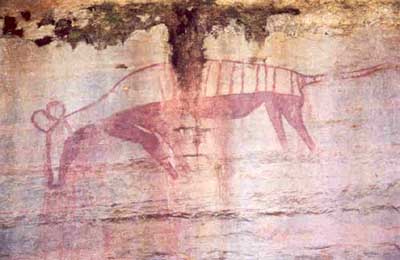 |
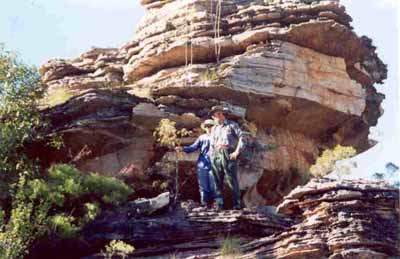 |
Surprises were occasionally found on solitary rocks, usually low, often hidden on the shaded side. If a good surface was available it was decorated, even tiny figures could be found on narrow ledges, while serpents, metres long, followed the curve of the wall. Finding a particular art site could be as difficult as locating the bower of the great bowerbird, but when found they both exuded a sense of being occupied.
|
|
The horizontally bedded sandstone dictates the size of a gallery. Ceilings of shelters often provide the largest surface though this can be quite rippled. Older work is darker in colour, mysterious shadows under the bright reds and yellows. Strange animals, are they extinct, are they telling a story? Our imagination was stimulated. |
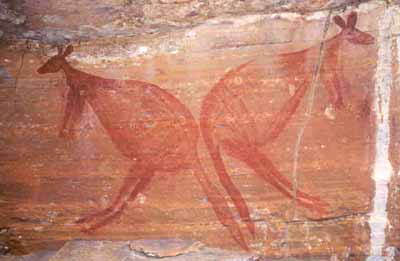 |
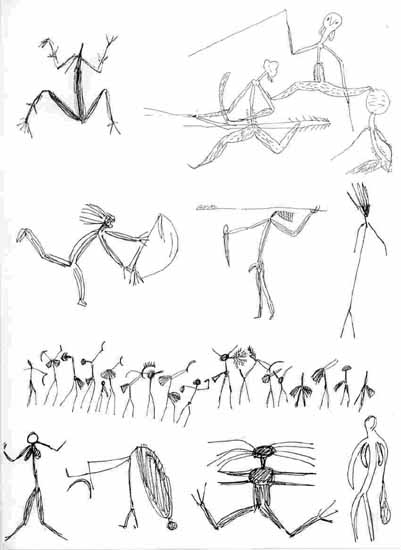 |
Climbing Hill 420 took twice as long as expected -two full days of serious rock scrambling, scrub bashing, and route searching to bypass cliffs and gullies. This steep place also had hidden treasures and signs of habitation. Rock arches were wide and shallow with art on the walls, or narrow and high. Water could be found in deep dark clefts surrounded by ferns -a wonderful habitat for wallaroos.
The multi-layered rock art is often difficult to photograph. Hence, sketching is another way of recording ones memories. The rock art gave this environment a sense of timelessness associated with human activity not normally found in many other Australian national parks.
|
Josephine Lawrence is a prize winning artist. She generously gave us permission to show some of the sketches she did on the trip on this site. If you would like to see more of her sketches from this trip, please click the link below.
Josephine Lawrence Gallery
Click here to see a gallery of photos from the Baroalba - Hill 420 area.
Click here for more information about our next trip to this area.
Click here to return to the Web magazine.






